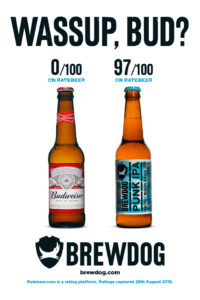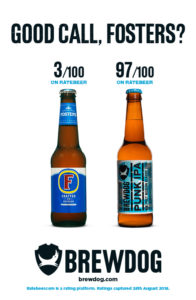
The explosion of craft beer in the UK, spearheaded by Scottish brewer BrewDog, has transformed our beer market. It’s not only taking an ever-increasing share out of the traditional lager and real ale categories, it’s also forced the big traditional beer brands to sit up, take notice and raise their games.
As a response to craft, many big beer brands have innovated with new products, new modern packaging designs, new and bold communications campaigns, by buying up-and coming breweries, and even scrapping original flagship beer recipes (I’m thinking of Carlsberg here). It’s not an exaggeration to say there’s been a beer revolution in this country.
But what about them apples?
Craft cider has been bubbling along. A range of new craft cider brands have launched, some brands are beginning to be snapped up (BrewDog bought London based Hawkes cider last year), the odd craft cider shop has popped up, but it hasn’t truly exploded yet, BrewDog style. And interestingly, the wider cider category doesn’t seem to have been impacted by, or reacted to, craft cider, just yet.
Surely this is only a matter of time. Cider is the perfect category for a craft segment to flourish.
In terms of the product, craft is all about not cutting corners and doing things properly. For cider, simplifying production with minimal intervention, with little or no added sugar and letting the fruit do the talking is a great craft story to tell. Natural and premium ciders have been doing this for a while, but perhaps consumers just don’t know enough about this yet.
Innovation and breaking traditional rules has been central to craft beer’s development, and cider has huge potential for new news and product innovation. From hazy and cloudy ciders, to the scale of dry to sweet flavours, to the range of different fruits and apple varieties and the different off and on trade serve options – the possibilities seem almost infinite. Cider can also scale its abv levels relativity easy – again a trend that craft beer has used, with higher, lower and non abv craft beers all adapting to, and influencing, consumer trends.
Celebrating provenance and knowing where ingredients have come from is also ingrained in craft, and cider is tailor made for this, perhaps more so than beer. Cider is a quintessentially British product, with positive ties to the West Country. We have a fantastic range of apples in the UK, so there’s no need to use imported varieties. This is different to beer, where the fruity and citrusy hops that most modern craft brewers use tend to come from the USA and New Zealand.
And perhaps most importantly, the accessible and easy taste of cider tends to appeal to younger, millennial consumers, both male and female.
Given all of this, you’d think this traditionally early adopting millennial audience would be fuelling enormous growth in craft cider, to match that of craft beer. But it hasn’t quite happened yet. Perhaps cider still suffers a little too much from the traditional old scrumpy, farmers with sideburns, country bumpkin imagery. Overly sweet warm cans of cider drunk at music festivals also spring to mind.

So what can ambitious craft cider brands learn from the rise of craft beer?
Well, one thing that made BrewDog stand out, as they became the fastest growing UK food and drink brand for five years on the trot, was their bold attitude and willingness to identify an enemy. This enemy was (and still is) mass market, mass produced big brand lager, and BrewDog went after it, with enormous success.
Craft cider has the same enemy within its category. Many of the big mass-produced cider brands feel a little tired, lacking in innovation, lacking in modernity, and perhaps lacking in relevance to younger audiences. So, if a craft cider brand can get their formula right, and persuade the trade that they have similar levels of ambition and bravery to match that of BrewDog, then the cider category if there to be truly shaken up.
And just like within beer, shaking things up could be good news for everyone. Whilst big cider brands will naturally start to get a little fidgety as craft cider’s market share rises, those that are willing to innovate and adapt to shifting trends, shouldn’t be too worried.

The great part of craft beer’s rise has been the way the big brands have reacted, upping their games, and putting more of their focus back on to the consumer and what they are really after. Genuine new news and new competition raises the standards all round. Which in the end, should be great news for cider drinkers.
Article by Jamie Williams, Managing Partner of creative agency isobel and a member of the British Guild of Beer Writers.

You must be logged in to post a comment Login